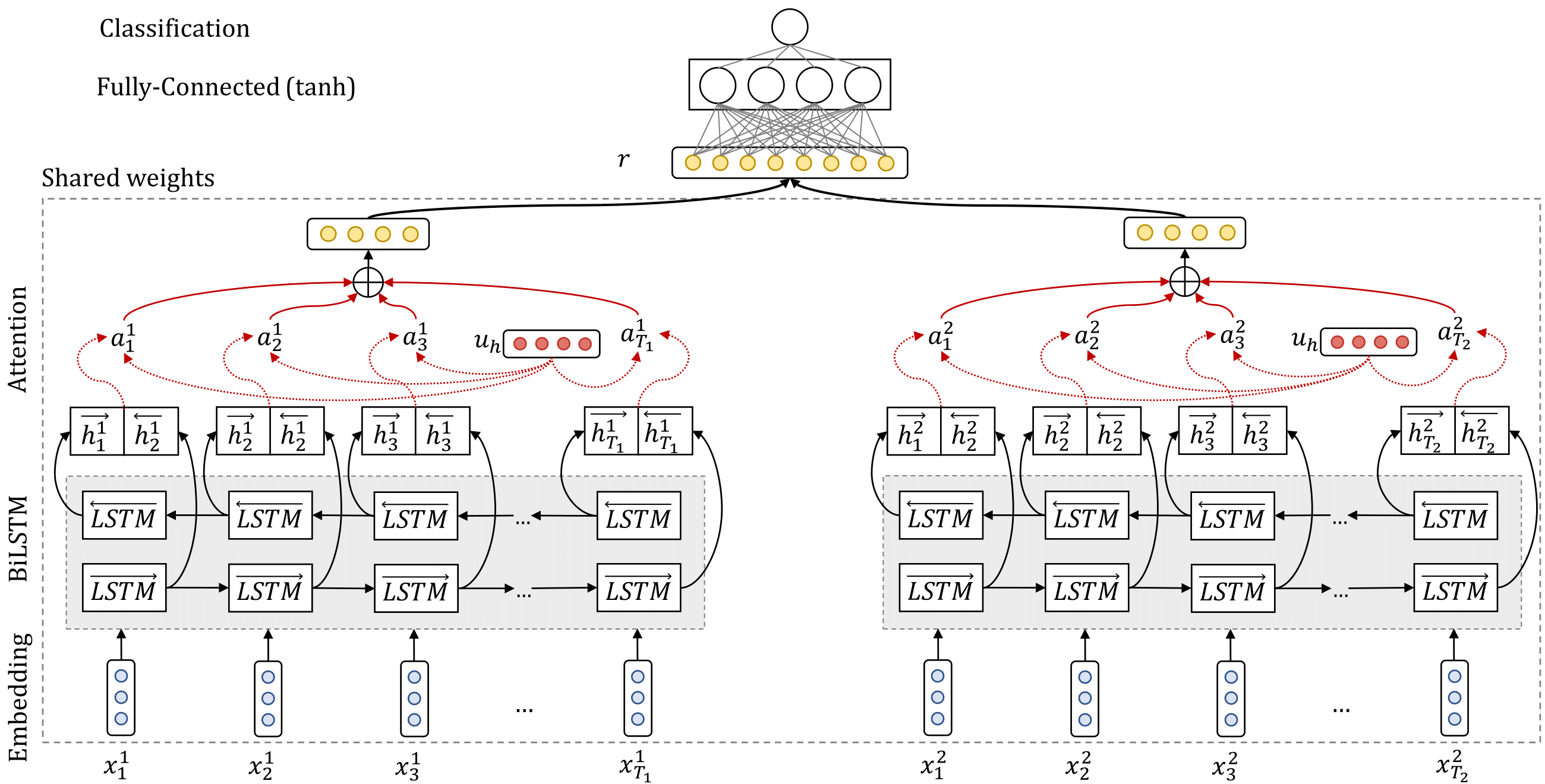This repository contains the source code for the models used for DataStories team's submission for SemEval-2017 Task 6 “#HashtagWars: Learning a Sense of Humor”. The model is described in the paper "SemEval-2017 Task 6: Siamese LSTM with Attention for Humorous Text Comparison".
Citation:
@InProceedings{baziotis-pelekis-doulkeridis:2017:SemEval1,
author = {Baziotis, Christos and Pelekis, Nikos and Doulkeridis, Christos},
title = {DataStories at SemEval-2017 Task 6: Siamese LSTM with Attention for Humorous Text Comparison},
booktitle = {Proceedings of the 11th International Workshop on Semantic Evaluation (SemEval-2017)},
month = {August},
year = {2017},
address = {Vancouver, Canada},
publisher = {Association for Computational Linguistics},
pages = {381--386}
}
 A higl-level overview of the model for SubTask A.
A higl-level overview of the model for SubTask A.
Notes
-
If what you are just interested in the source code for the model then just see models/task6A_models.py.
-
The models were trained using Keras 1.2. In order for the project to work with Keras 2 some minor changes will have to be made.
pip install -r /datastories-semeval2017-task6/requirements.txt
The models were trained on top of word embeddings pre-trained on a big collection of Twitter messages. We collected a big dataset of 330M English Twitter messages posted from 12/2012 to 07/2016. For training the word embeddings we used GloVe. For preprocessing the tweets we used ekphrasis, which is also one of the requirements of this project.
You can download one of the following word embeddings:
- datastories.twitter.50d.txt: 50 dimensional embeddings
- datastories.twitter.100d.txt: 100 dimensional embeddings
- datastories.twitter.200d.txt: 200 dimensional embeddings
- datastories.twitter.300d.txt: 300 dimensional embeddings
Place the file(s) in /embeddings folder, for the program to find it.
In order to specify which word embeddings file you want to use,
you have to set the values of WV_CORPUS and WV_WV_DIM in task6A.py and task6A_LOO.py respectively.
The default values are:
WV_CORPUS = "datastories.twitter"
WV_DIM = 300The convention we use to identify each file is:
{corpus}.{dimensions}d.txt
This means that if you want to use another file, for instance GloVe Twitter word embeddings with 200 dimensions,
you have to place a file like glove.200d.txt inside /embeddings folder and set:
WV_CORPUS = "glove"
WV_DIM = 200You will find the programs for training the Keras models, in /models folder.
models
│ task6A_models.py : contains the Keras models
│ task6A.py : program for training the model for Task6A
│ task6A_LOO.py : program for Leave-One-Out cross validation
Semeval 2017 Task6A: For training a model for Semeval 2017 Task6A, then you have to run task6A.py.
Read the source code and configure the program using the corresponding flags.
If running with flag PERSIST=True then the checkpointing will be ON.
This means that the model weights with the corresponding word indices will be saved to disk:
models/cp_model_task6_sub1.hdf5
models/cp_model_task6_sub1_word_indices.pickle
Usually after 1 or 2 epochs the network will start to overfit so you can just stop the execution.
#HashtagWars evaluation:
In order to test our model using the evaluation method (Leave-One-Out cross validation) in
Potash et al. "# HashtagWars: Learning a Sense of Humor." arXiv:1612.03216,
you have to run task6A_LOO.py.
Read the source code and configure the program using the corresponding flags.
The program will save the results of each run and place them in /models/results/.
You can evaluate those results by running /models/results/results_loo.py.
The submissions/ folder contains a trained model with the corresponding word indices and the generated submission files.
If you want to generate new submissions for the SemEval test set,
just train a model with task6A.py and move the files
models/cp_model_task6_sub1.hdf5
models/cp_model_task6_sub1_word_indices.pickle
to the submissions/ folder.
You can generate new submissions and evaluate the performance of a model with submissions/submit_task6_1.py.